NCERT Exemplar for Class 9 Maths - Quadrilaterals - Free PDF Download
Free PDF download of NCERT Exemplar for Class 9 Math Chapter 8 - Quadrilaterals solved by expert Math teachers on Vedantu.com as per NCERT (CBSE) Book guidelines. All Chapter 8 - Quadrilaterals exercise questions with solutions to help you revise the complete syllabus and score more marks in your examinations. Every NCERT Solution is provided to make the study simple and interesting on Vedantu. Subjects like Science, Math, English will become easy to study if you have access to NCERT Solution for Class 9 Science, Math solutions and solutions of other subjects. You can also download NCERT Solutions for Class 9 Math to help you revise the complete syllabus and score more marks in your examinations.
NCERT Exemplar Class 9 Math Solutions can be considered as the best study material as they contain direct answers for all fundamental to advanced level questions of the Chapter. This section of NCERT Class 9 Math Exemplar contains 4 sections that cover around 56 questions. These questions cover various points like demonstrating if a figure is a Parallelogram or Rhombus, tracking down the points of various kinds of figures like Trapezium, Parallelogram, Square, and so forth. The Midpoint theorem is one of the vital concepts of this section.
NCERT Exemplar Class 9 Math Chapter 8 contains different types of Exemplar problems, for example, MCQs that may appear simple to solve at one yet require a proper comprehension of the Chapter. Additionally, there are state true and false and fill in the blanks alongside long answer questions that are of shifting difficulty levels.
Access NCERT Exemplar Solutions for Class 9 Mathematics Chapter 8 - Quadrilaterals
Sample question 1: Diagonals of a parallelogram ABCD intersect at O. If
(A) 90º
(B) 50º
(C) 40º
(D) 10º
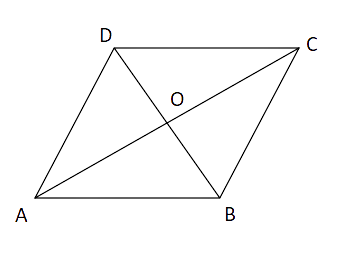
Ans: Option C is correct.
Also,
Now, In
DC || AB and AC is the transversal
i.e.
Exercise 8.1
1. Three angles of a quadrilateral are 75º, 90º and 75º. The fourth angle is
(A) 90º
(B) 95º
(C) 105º
(D) 120º
Ans: The correct answer is option D.
The sum of all angles of a quadrilateral is 360º. The three angles are 75º, 90º and 75º. Let the fourth angle be xº.
Thus, the fourth angle is 120º.
2. A diagonal of a rectangle is inclined to one side of the rectangle at 25º. The acute angle between the diagonals is
(A) 55º
(B) 50º
(C) 40º
(D) 25º
Ans: Option B is correct.
Quadrilateral ABCD is a rectangle. The diagonals of a rectangle are equal and bisect each other. Diagonal AC is inclined to the side AB at an angle of 25º.
Side AO = Side OB
In
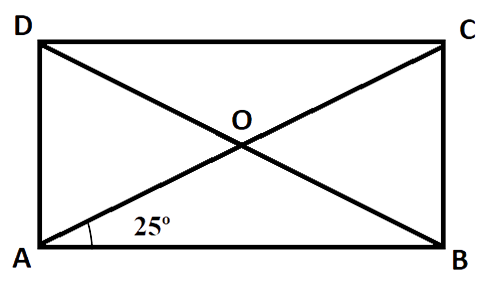
Now,
Angle between the diagonals is 50º.
3. ABCD is a rhombus such that ∠ACB = 40º. Then ∠ADB is
(A) 40º
(B) 45º
(C) 50º
(D) 60º
Ans: Option C is correct.
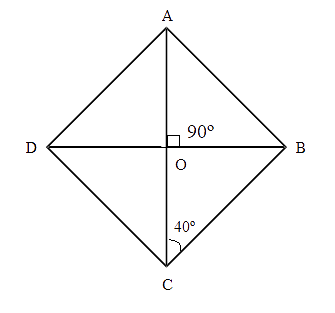
In
4. The quadrilateral formed by joining the mid-points of the sides of a quadrilateral PQRS, taken in order, is a rectangle, if
(A) PQRS is a rectangle
(B) PQRS is a parallelogram
(C) diagonals of PQRS are perpendicular
(D) diagonals of PQRS are equal.
Ans: The correct answer is option C.

The rectangle ABCD is formed by joining the midpoints of quadrilateral PQRS. We know that the diagonals of a rectangle are equal. So, AC = BD.
Similarly, PQ = QR.
Therefore, quadrilateral PQRS is a rhombus. In a rhombus, the diagonals are perpendicular. Hence, diagonals of PQRS are perpendicular.
5. The quadrilateral formed by joining the mid-points of the sides of a quadrilateral PQRS, taken in order, is a rhombus, if
(A) PQRS is a rhombus
(B) PQRS is a parallelogram
(C) diagonals of PQRS are perpendicular
(D) diagonals of PQRS are equal.
Ans: The correct answer is option D.

The rhombus ABCD is formed by joining the midpoints of quadrilateral PQRS. In a rhombus the diagonals are equal and bisect each other. So, in order for quadrilateral ABCD to be a rhombus the diagonals of quadrilateral PQRS should be equal.
6. If angles A, B, C and D of the quadrilateral ABCD, taken in order, are in the ratio 3:7:6:4, then ABCD is a
(A) rhombus
(B) parallelogram
(C) trapezium
(D) kite
Ans: Option C is correct.
The angles A, B, C and D are in the ratio 3:7:6:4.
Let x be the common multiple.
Thus, the angles are
In a rhombus, parallelogram and kite the opposite angles are equal. So, the quadrilateral ABCD will be a trapezium.
7.If bisectors of
(A) rectangle
(B) rhombus
(C) parallelogram
(D) quadrilateral whose opposite angles are supplementary
Ans: Option D is correct.
The required figure is as follows:
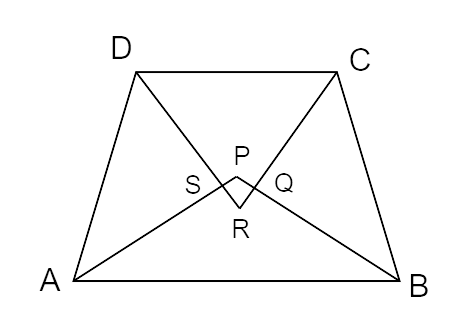
Now, In
From (i) and (ii) we get,
Similarly,
By adding (iii) and (iv) we get,
Therefore, the opposite angles in quadrilateral PQRS are supplementary.
8. If APB and CQD are two parallel lines, then the bisectors of the angles APQ, BPQ, CQP and PQD form
(A) a square
(B) a rhombus
(C) a rectangle
(D) any other parallelogram
Ans: Option C is correct.
The required figure is as follows:
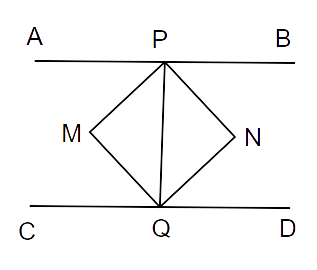
Lines APB and CQD are parallel.
Here, MP and NQ are the angle bisectors of
Dividing both the sides by 2 we get,
But these are alternate angles. So, MP || QN.
Similarly,
So, PN || QM.
Thus, quadrilateral PNQM is a parallelogram.
As, CQD is a line.
MQ and NQ are the bisectors of
Therefore, quadrilateral PNQM is a rectangle.
9. The figure obtained by joining the mid-points of the sides of a rhombus, taken in order, is
(A) a rhombus
(B) a rectangle
(C) a square
(D) any parallelogram
Ans: Option B is correct.
The required figure is as follows:
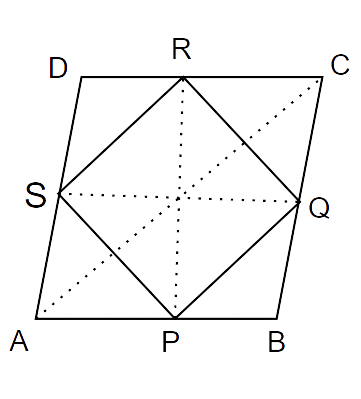
In
P and Q are the midpoints of AB and BC respectively.
By Midpoint theorem,
PQ || AC and
Similarly,
In
S and R are the midpoints of AD and DC respectively.
By Midpoint theorem,
AC || SR and
From (i) and (ii) we get,
PQ || SR and PQ = SR
Thus, quadrilateral PQRS is a parallelogram.
Now,
ASQB is a parallelogram. So, AB = SQ.
Also,
PRCB is a parallelogram. So, BC = PR.
But, BC = AB (Sides of a rhombus are equal)
AB = PR
So, SQ = PR.
A parallelogram with equal diagonals is a rectangle.
Therefore, the figure obtained by joining the mid-points of the sides of a rhombus will be a rectangle.
10. D and E are the mid-points of the sides AB and AC of ABC and O is any point on side BC. O is joined to A. If P and Q are the mid-points of OB and OC respectively, then DEQP is
(A) a square
(B) a rectangle
(C) a rhombus
(D) a parallelogram
Ans: Option D is correct.
The required figure is as follows:
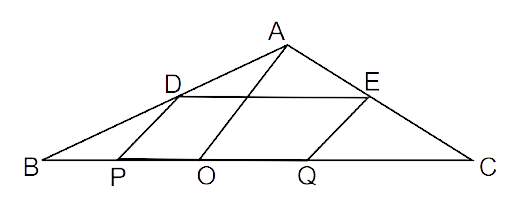
Since the line segment joining the mid-points of any two sides of a triangle is parallel to the third side and is half of it.
So, DE || BC i.e. DE || PQ ..(i)
Now, In
Points D and P are the midpoints of AB and BO respectively.
Thus, DP || AO ..(ii)
Similarly,
In
Points E and Q are the midpoints of AC and CO respectively.
Thus, EQ || AO ..(iii)
From (ii) and (iii)
DP || EQ ..(iv)
From (i) and (iv)
DE || PQ and DP || EQ (opposite sides of quadrilateral DEQP)
This quadrilateral DEQP is a parallelogram.
11. The figure formed by joining the mid-points of the sides of a quadrilateral ABCD, taken in order, is a square only if,
(A) ABCD is a rhombus
(B) diagonals of ABCD are equal
(C) diagonals of ABCD are equal and perpendicular
(D) diagonals of ABCD are perpendicular
Ans: Option C is correct.
The required figure is as follows:
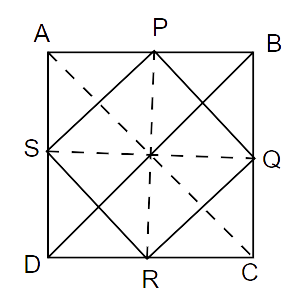
Given: In quadrilateral ABCD,
P, Q, R and S are the mid-points of sides AB, BC, CD and AD respectively.
Thus, PQRS is a square.
So, PQ = RQ = RS = SP ..(i)
And PR = SQ
But, SQ = AB and PR = BC
Thus, AB = BC
Hence, all the sides of quadrilateral ABCD are equal.
So, the quadrilateral ABCD can either be a rhombus or a square.
In
By mid-point theorem,
PQ || AC so,
Similarly, In
By mid-point theorem,
SP || DB so,
But PQ = SP ..(from i)
From (ii) and (iii),
Here the diagonals of quadrilateral ABCD are equal. So, quadrilateral ABCD is a square.
In a square the diagonals are equal and perpendicular.
12. The diagonals AC and BD of a parallelogram ABCD intersect each other at the point O. If ∠DAC = 32º and ∠AOB = 70º, then ∠DBC is equal to
(A) 24º
(B) 86º
(C) 38º
(D) 32º
Ans: Option C is correct.
Given:
AD is parallel to BC and AC is the transversal.

In
So, by exterior angle property,
Thus,
13. Which of the following is not true for a parallelogram?
(A) opposite sides are equal
(B) opposite angles are equal
(C) opposite angles are bisected by the diagonals
(D) diagonals bisect each other.
Ans: Option C is correct.
In a parallelogram opposite sides and angles are equal. The diagonals bisect each other. Thus, opposite angles bisected by the diagonals is not true.
14. D and E are the mid-points of the sides AB and AC respectively of ABC. DE is produced to F. To prove that CF is equal and parallel to DA, we need an additional information which is
(A)
(B) AE = EF
(C) DE = EF
(D)
Ans: Option C is correct.
The required figure is as follows:
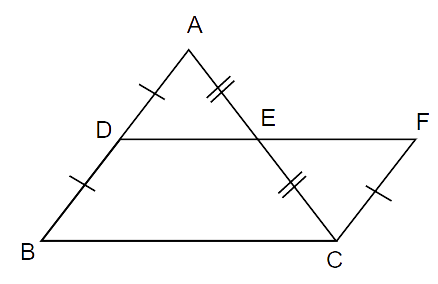
Given: AD = DB and AE = EC
CF is parallel to AD and D is the midpoint of AB
Thus, AD = DB = FC
Now, In
(i) AD = FC ..(given)
(ii)
(iii) AE = CE ..(E is the midpoint of AC)
Thus, by SAS test
DE = EF (C.P.C.T)
Thus, AD || CF
The additional information we need is DE = EF.
Short Answer Questions with Reasoning
Sample Question 1: ABCD is a parallelogram. If its diagonals are equal, then find the value of
Ans: A parallelogram with equal diagonals is a rectangle. So, ABCD is a rectangle. Hence,
Sample Question 2: Diagonals of a rhombus are equal and perpendicular to each other. Is this statement true? Give reason for your answer.
Ans: The given statement is false. It is because in a rhombus the diagonals are perpendicular bisectors of each other but they are not equal.
Sample Question 3: Three angles of a quadrilateral ABCD are equal. Is it a parallelogram? Why or why not?
Ans: The quadrilateral ABCD will not be a parallelogram if the three equal angles are acute angles. Because then the fourth angle will be greater than the three angles.
Sample Question 4: Diagonals AC and BD of a quadrilateral ABCD intersect each other at O such that OA: OC = 3: 2. Is ABCD a parallelogram? Why or why not?
Ans: Diagonals of a parallelogram are perpendicular bisectors of each other. But, here the ratio of OA to OC is not equal. Hence, quadrilateral ABCD is not a parallelogram.
Exercise 8.2
1. Diagonals AC and BD of a parallelogram ABCD intersect each other at O. If OA = 3 cm and OD = 2 cm, determine the lengths of AC and BD.
Ans: The diagonals of a parallelogram bisect each other.

2. Diagonals of a parallelogram are perpendicular to each other. Is this statement true? Give reason for your answer.
Ans: The given statement is false. The diagonals of a parallelogram bisect each other but not at 90º.
3. Can the angles
Ans: The sum of all angles of a quadrilateral is 360º.
The sum of the given four angles =
Therefore, the angles
4. In quadrilateral ABCD,
Ans: In
Hence, the special name of the quadrilateral ABCD is trapezium.
5. All the angles of a quadrilateral are equal. What special name is given to this quadrilateral?
Ans: A quadrilateral's angles are all equal. A quadrilateral's sum of angles is also 360º. As a result, each quadrilateral angle is 90º. As a result, the quadrilateral in question is a rectangle. As a result, the special term for a quadrilateral is rectangle.
6. Diagonals of a rectangle are equal and perpendicular. Is this statement true? Give reason for your answer.
Ans: In a rectangle the diagonals are equal but not perpendicular bisectors of each other. Hence, the given statement is false.
7. Can all the four angles of a quadrilateral be obtuse angles? Give reason for your answer.
Ans: No, since the quadrilateral's total of four angles will be more than 360º, but the sum of four angles of a quadrilateral is always 360º.
8. In
Ans: Given:
In
AB = 5 cm
BC = 8 cm
AC= 7 cm
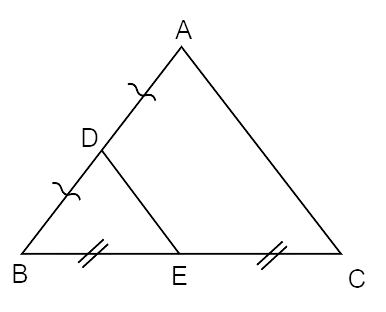
Thus, Using the midpoint theorem,
DE is half of AC.
Therefore, DE = 3.5 cm.
9. In Fig.8.1, it is given that BDEF and FDCE are parallelograms. Can you say that BD = CD? Why or why not?
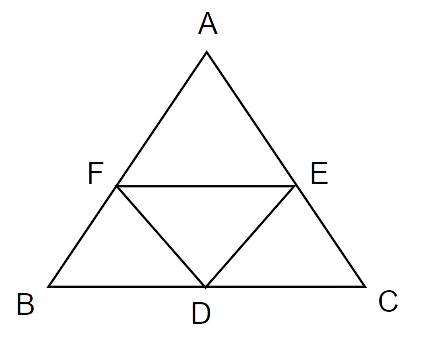
Ans: Here we have two parallelograms, BDEF and DFEC.
We know that opposite sides of a parallelogram are equal.
In parallelogram BDEF,
BD = FE ..(i)
Similarly,
In parallelogram DFEC
CD = FE ..(ii)
From (i) and (ii),
BD = CD
10. In Fig.8.2, ABCD and AEFG are two parallelograms. If

Ans: In parallelogram ABCD,
Opposite angles of a parallelogram are equal.
Now, In parallelogram AEFG,
11. Can all the angles of a quadrilateral be acute angles? Give reason for your answer.
Ans: An acute angle measures less than 90º. if all the angles of the quadrilateral will be acute then the total sum of the angles will be less than 360º. Therefore, all the angles of a quadrilateral cannot be acute.
12. Can all the angles of a quadrilateral be right angles? Give reason for your answer.
Ans: Yes, a quadrilateral's angles can all be right angles. The total of the angles of a quadrilateral will equal 360º.
13. Diagonals of a quadrilateral ABCD bisect each other. If
Ans: In quadrilateral ABCD the diagonals bisect each other. Thus, the given quadrilateral ABCD is a parallelogram.
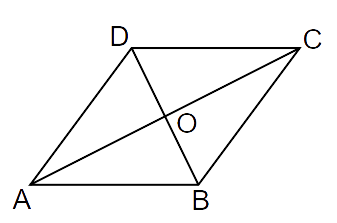
In a parallelogram the adjacent angles are supplementary.
14. Opposite angles of a quadrilateral ABCD are equal. If AB = 4 cm, determine CD.
Ans: If the opposite angles of quadrilateral ABCD are equal then the given quadrilateral ABCD is a parallelogram.
In a parallelogram opposite sides are equal.
AB and CD are opposite sides of the quadrilateral ABCD.
AB = CD
Therefore, CD = 4cm
(D) Short Answer Questions
Sample Question 1: Angles of a quadrilateral are in the ratio 3: 4: 4: 7. Find all the angles of the quadrilateral.
Ans: The angles of a quadrilateral are in the ratio 3: 4: 4: 7.
Let x be the common multiple. So, the angles will be 3x, 4x, 4x and 7x.
The sum of all angles of a quadrilateral is 360º.
The angles are,
So the angles of the quadrilateral are 60º, 80º, 80º and 140º.
Sample Question 2: In Fig.8.3, X and Y are respectively the mid-points of the opposite sides AD and BC of a parallelogram ABCD. Also, BX and DY intersect AC at P and Q, respectively. Show that AP = PQ = QC.
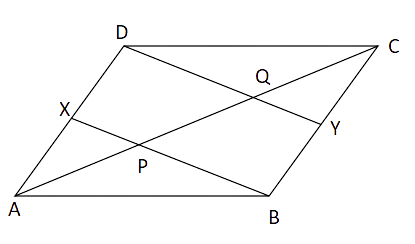
Ans: Y is the midpoint of BC and X is the midpoint of AD.
ABCD is a parallelogram.
So, AD = BC
DX = BY
Thus, XDYB is a parallelogram
In
Also, in
CQ = PQ (ii)
From (i) and (ii)
AP = PQ = QC.
Sample Question 3: In Fig.8.4, AX and CY are respectively the bisectors of the opposite angles A and C of a parallelogram ABCD. Show that AX || CY.
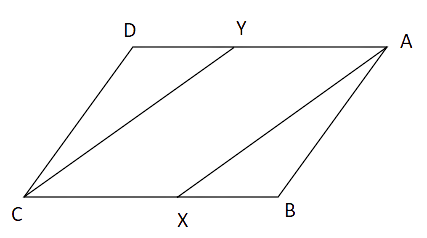
Ans: ABCD is a parallelogram.
(AX and CY )are the bisectors of
Now, YA || CX
We know that,
Interior angles of the same side of the transversal are supplementary.
Therefore, AX || CY
Exercise 8.3
1. One angle of a quadrilateral is of
Ans: The sum of all angles of a quadrilateral is
Let the other three angles be x.
Each of the three angles will be of
2. ABCD is a trapezium in which AB || DC and
Ans: Quadrilateral ABCD is a trapezium.
Angles on the same side of the trapezium are supplementary.
Similarly,
Therefore,
3. The angle between two altitudes of a parallelogram through the vertex of an obtuse angle of the parallelogram is 60º. Find the angles of the parallelogram.
Ans: Given: DP and DQ are the perpendicular to side AB and BC respectively.
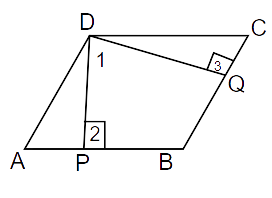
In quadrilateral DPBQ,
Now,
Adjacent angles of parallelogram are supplementary.
4. ABCD is a rhombus in which altitude from D to side AB bisects AB. Find the angles of the rhombus.
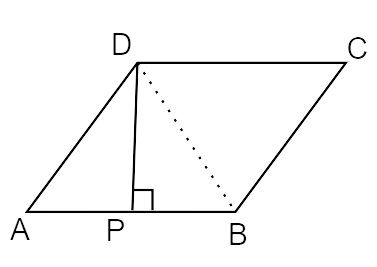
Ans: According to the question,
DP is perpendicular to side AB and AP = PB
Now,
In
AP = PB (given)
DP = PD (common side)
Also, diagonals of a rhombus bisect the angles.
From (i) and (ii)
Sum of adjacent angles in a rhombus is supplementary.
Opposite angles of a rhombus are congruent.
5. E and F are points on diagonal AC of a parallelogram ABCD such that AE = CF. Show that BFDE is a parallelogram.
Ans: Given: Quadrilateral ABCD is a parallelogram.
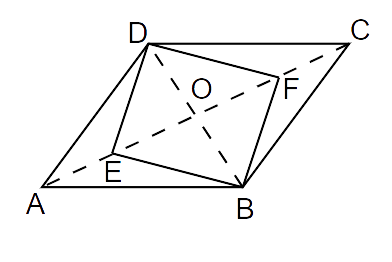
Diagonals of a parallelogram bisect each other.
According to the diagram, A - E – O – F - C
AE + OE = CF + OF
Also, AE = CF (given)
And OD = OB
Hence, BEDF is a parallelogram.
6. E is the mid-point of the side AD of the trapezium ABCD with AB || DC. A line through E drawn parallel to AB intersects BC at F. Show that F is the mid-point of BC. [Hint: Join AC]

Ans: In trapezium ABCD, AB || CD and FE are drawn parallel to CD.
In
By converse of Midpoint theorem,
O is the midpoint of AC.
Now,
In
By converse of Midpoint theorem,
F is the midpoint of BC.
7. Through A, B and C, lines RQ, PR and QP have been drawn, respectively parallel to sides BC, CA and AB of a ABC as shown in Fig.8.5. Show that
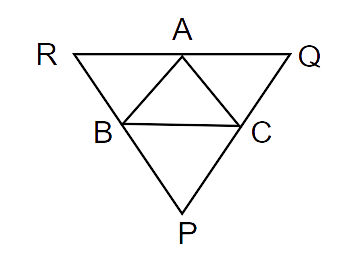
Ans: Given: AB||PQ, BC || RQ and AB || PQ
TPT:
Proof: In parallelogram ACBR,
BC = AR (Opposite sides of a parallelogram are equal) ..(i)
Also,
In parallelogram ABCQ,
BC = AQ (Opposite sides of a parallelogram are equal) ..(ii)
From (i) and (ii)
BC = AR = AQ ..(iii)
Now,
In the above figure, R – A – Q ,
Hence proved.
8. D, E and F are the mid-points of the sides BC, CA and AB, respectively of an equilateral triangle ABC. Show that DEF is also an equilateral triangle.

Ans: Given:
D is the midpoint of BC, E is the midpoint of AC and F is the midpoint of AB.
According to midpoint theorem,
Also,
Similarly,
But, AB = BC = AC
Hence,
9. Points P and Q have been taken on opposite sides AB and CD, respectively of a parallelogram ABCD such that AP = CQ (Fig. 8.6). Show that AC and PQ bisect each other.
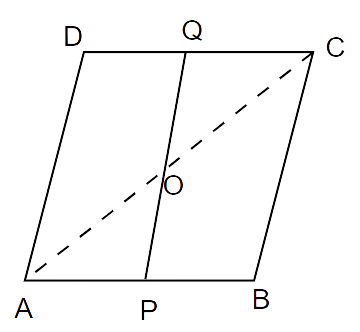
Ans: In
AP = CQ (given)
By ASA test,
Therefore, PQ and AC bisect each other.
10. In Fig. 8.7, P is the mid-point of side BC of a parallelogram ABCD such that
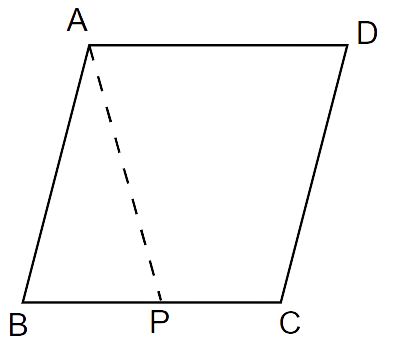
Ans: In the parallelogram ABCD,
BP = PC
Adjacent angles in a parallelogram are supplementary.
Now,
In
Sum of angles in a triangle is
PB = AB (sides opposite to congruent angles are equal) ..(iii)
AD = BC (Opposite sides of a parallelogram are equal)
Also, P is the midpoint of BC
From (iii)
But AD = CD (Opposite sides of a parallelogram are equal)
(E) Long Answer Questions
Sample Question 1: PQ and RS are two equal and parallel line-segments. Any point M not lying on PQ or RS is joined to Q and S and lines through P parallel to QM and through R parallel to SM meet at N. Prove that line segments MN and PQ are equal and parallel to each other.
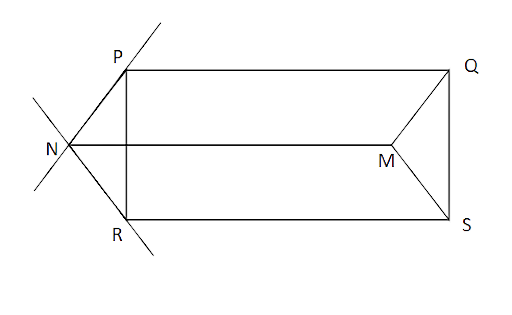
Ans: Given: PQ = RS and PQ || RS.
PQSR is a parallelogram.
Thus, PR = QS and PR || QS (i)
Now, PR || QS
Interior angles on the same side of the transversal are supplementary.
Therefore,
Also, PN || QM
Therefore,
Thus,
Similarly,
By ASA test of congruence and (from i, iv and v)
Therefore,
Thus, PN = QM and NR = MS (by CPCT)
Since, PN = QM and PN || QM,
Thus, PQMN is a parallelogram.
Therefore, MN = PQ and MN || PQ
Sample Question 2: Prove that a diagonal of a parallelogram divides it into two congruent triangles.

Ans: In
(i)
(ii) AC =CA (common side)
(iii)
By ASA test of congruence,
Sample Question 3: Show that the quadrilateral formed by joining the mid-points the sides of a rhombus, taken in order, forms a rectangle.
Ans: Quadrilateral ABCD is a rhombus
P, Q, R and S be the mid-points of sides AB, BC, CD and DA, respectively
Construction: Join BD and AC
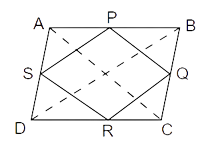
In
S and P are the midpoints of AD and AB
By midpoint theorem,
Similarly,
Thus, SP || RQ
Therefore, PQRS is a parallelogram.
We know that diagonals of a rhombus are perpendicular to each other.
Now,
SP || BD and PQ || AC
Also,
Thus,
Therefore, PQRS is a rectangle.
Sample Question 4: A diagonal of a parallelogram bisects one of its angle. Prove that it will bisect its opposite angle also.
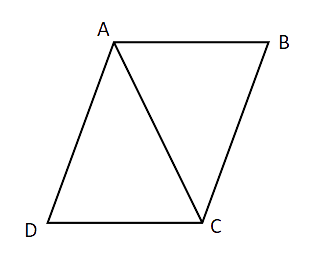
Ans: AC bisects
AB || CD and AC is a transversal
Similarly,
AD || BC and AD is the transversal
From (i), (ii) and (iii)
Exercise 8.4
1. A square is inscribed in an isosceles right triangle so that the square and the triangle have one angle in common. Show that the vertex of the square opposite the vertex of the common angle bisects the hypotenuse.
Ans: Given: Quadrilateral CPQR is inscribed in the isosceles right triangle
Quadrilateral CPQR is a square
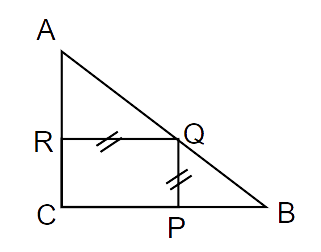
Also,
But RC = CP
Now,
In
BP = AR
PQ = RQ
Thus, QB = AQ (CPCT)
This infers hypotenuse AB is bisected by Q.
2. In a parallelogram ABCD, AB = 10 cm and AD = 6 cm. The bisector of
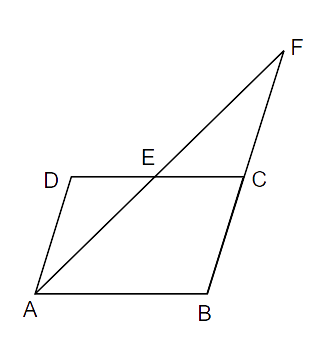
Ans: Given: Quadrilateral ABCD is a parallelogram.
AB = 10 cm
AD = 6 cm
AF is the bisector of
Also, AD || BC and AF is the transversal
Thus,
FB = 10 cm
AD = BC = 6 cm (Opposite sides of a parallelogram are equal)
Therefore, CF = 4 cm.
3. P, Q, R and S are respectively the mid-points of the sides AB, BC, CD and DA of a quadrilateral ABCD in which AC = BD. Prove that PQRS is a rhombus.
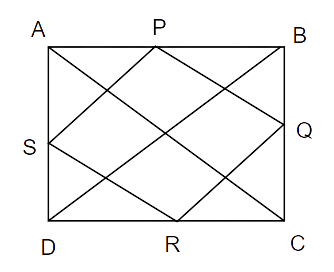
Ans: In quadrilateral ABCD,
P, Q, R and S are the mid-point of the sides AB, BC, CD and AD respectively.
Now,
In
PQ ||AC and SR || AC
and
Thus,
PQ = SR
In quadrilateral PQRS,
PQ = SR and
Thus, quadrilateral PQRS is a parallelogram.
Now, In
Similarly, In
P and S are the midpoints of AB and AD respectively.
By midpoint theorem,
But, AC = BD [From (i)]
From (iii) and (iv) we get,
A parallelogram with adjacent sides equal is a rhombus.
Therefore, quadrilateral PQRS is a rhombus.
4. P, Q, R and S are respectively the mid-points of the sides AB, BC, CD and DA of a quadrilateral ABCD such that
Ans: We know that,

Now,
In
PQ || AC and SR || AC
Also, By midpoint theorem,
Similarly,
PS || RQ and PS = RQ
A quadrilateral with opposite sides equal and parallel and diagonals bisect at
Thus quadrilateral PQRS is a rectangle.
5. P, Q, R and S are respectively the mid-points of sides AB, BC, CD and DA of quadrilateral ABCD in which AC = BD and
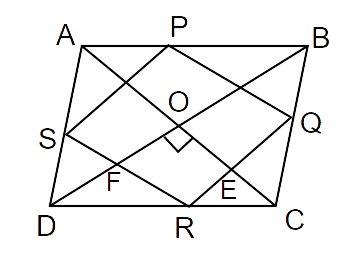
Ans: In
PQ || AC and SR || AC
Also, By midpoint theorem,
Similarly,
PS || RQ and
But, AC = BD
PQ = SR = PS = RQ
Thus, all the sides are equal.
Now, in EOFR,
So,
Similarly,
Therefore, Quadrilateral PQRS is a square.
6. A diagonal of a parallelogram bisects one of its angles. Show that it is a rhombus
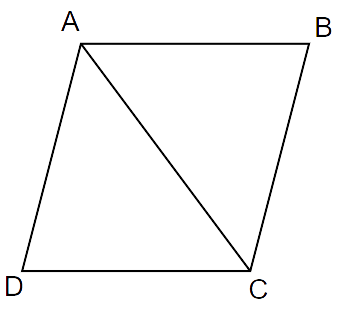
Ans: Diagonal AC bisects
Now, AD || BC and AC is the transversal
From (i) and (ii)
Thus, AC = BC (opposite sides of equal angles)
But, AD = BC
Hence ABCD is a rhombus.
7. P and Q are the mid-points of the opposite sides AB and CD of a parallelogram ABCD. AQ intersects DP at S and BQ intersects CP at R. Show that PRQS is a parallelogram.
Ans: Given: P is the midpoint of AB and Q is the midpoint of DC.

ABCD is a parallelogram.
AB = CD
AP = QC
AQ || PC and PR || QS ..(i)
Also, AB || DC and BP || DQ
AB = DC
As P and Q are the midpoints of AB and DC
BP = QD and BP || DQ
Thus, BQDP is a parallelogram.
So, DP || BQ and PS || QR.. (ii)
From (i) and (ii)
QS || PR and PS || RQ
Therefore, quadrilateral PRQS is a parallelogram.
8. ABCD is a quadrilateral in which AB || DC and AD = BC. Prove that

Ans: Given: AB || DC
AD = BC
Draw AP and CQ perpendicular to AB.
In
(i)
(ii) AD = BC (given)
(iii) DP = CQ (distance between two parallel lines)
By RHS criterion of congruence,
Now, AB || CD, AD and CB are transversals
The sum of corresponding angles is supplementary.
Hence proved.
9. In Fig. 8.11, AB || DE, AB = DE, AC || DF and AC = DF. Prove that BC || EF and BC = EF.
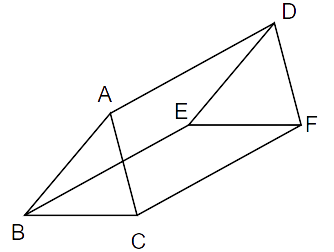
Ans: Given: AB || DE and AB = DE
AC||DF and AC = DF
TPT: BC||EF and BC = EF
Proof: In
CA || FD and CA = FD
Thus,
So, DA || CF and DA = CF ..(i)
Also, in
BA || ED and BA = ED
Thus,
So, AD || EB and AD = BE (ii)
From (i) and (ii) we get,
DA = CF = BE and FC || BE (iii)
Now,
In
CF = BE (from iii)
FC || BE
Thus,
So, CB = EF and CB || EF.
Therefore, proved.
10. E is the mid-point of a median AD of ABC and BE is produced to meet AC at F. Show that
Ans: Given: AE = ED
Construction: BE is produced to meet AC at F and is parallel to DG.
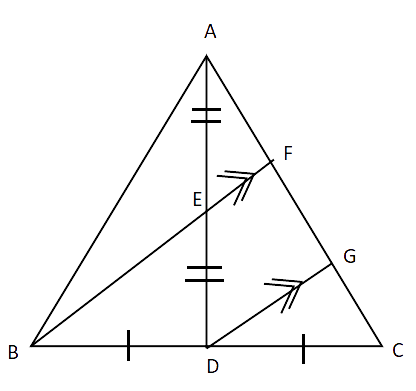
Proof: In
E is the midpoint of AD so AE = ED and EF || GD
By converse of midpoint theorem,
AF = FG ..(i)
Similarly, in
D is the midpoint of BC so BD = DC and BF || DC
By converse of midpoint theorem,
FG = GC ..(ii)
From equation (i) and (ii) we get,
AF = FG = GC ..(iii)
Now, for side AC, A-F-G-C
Hence proved.
11. Show that the quadrilateral formed by joining the mid-points of the consecutive sides of a square is also a square.
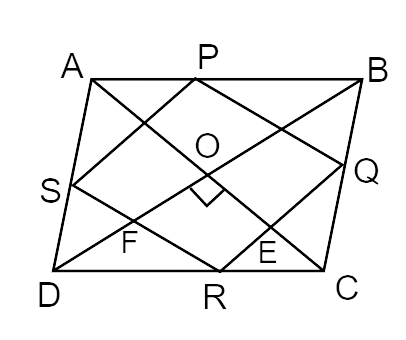
Ans: In
PQ || AC and SR || AC
Also, By midpoint theorem,
Similarly,
PS || RQ and
But, we know that diagonals of a square are equal and bisect each other.
So, AC = BD
Thus, all the sides are equal.
Now, in EOFR,
So,
Similarly,
Therefore, Quadrilateral PQRS is a square.
12. E and F are respectively the mid-points of the non-parallel sides AD and BC of a trapezium ABCD. Prove that EF || AB and
Ans: Given: E is the midpoint of AD and F is the midpoint of BC
Construction: Join CE produced at G to meet AB.
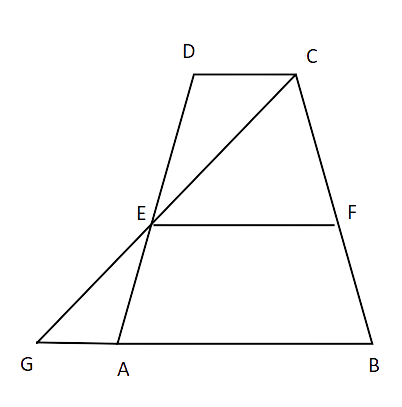
Proof: In
(i)
(ii)
(iii) EA = ED (E is the midpoint of AD)
By AAS test of congruence,
Thus, AG = DC and EG = EC (by CPCT)
Now, in
F is the midpoint of BC and E is the midpoint of CG,
So, by midpoint theorem,
EF || AB
Also, by midpoint theorem
But, BG = AG + AB
Hence proved.
13. Prove that the quadrilateral formed by the bisectors of the angles of a parallelogram is a rectangle.

Ans: Quadrilateral ABCD is a parallelogram.
The adjacent angles of a parallelogram are supplementary.
AR and DP are the bisectors of
Now, In
Thus,
Similarly,
All the four vertices of quadrilateral PQRS have a right angle.
Therefore, quadrilateral PQRS is a rectangle.
14. P and Q are points on opposite sides AD and BC of a parallelogram ABCD such that PQ passes through the point of intersection O of its diagonals AC and BD. Show that PQ is bisected at O.
Ans: In

(i)
(ii) AO = OC (Diagonals of a parallelogram bisect each other)
(iii)
By ASA test of congruence,
PO = QO (by CPCT)
Therefore, PQ is bisected at O.
15. ABCD is a rectangle in which diagonal BD bisects
Ans: ABCD is a rectangle.
Diagonal BD bisects

In
(i)
(ii)
(iii) BD = DB (common side)
By AAS test of congruence,
DC = AB and BC = AD (by CPCT) ..(i)
Also, opposite sides of a rectangle are congruent.
From (i) and (ii) we get,
AB = BC = CD = AD
Therefore, ABCD is a square.
16. D, E and F are respectively the mid-points of the sides AB, BC and CA of a triangle ABC. Prove that by joining these mid-points D, E and F, the triangles ABC is divided into four congruent triangles.
Ans: Sides AB, BC and CA have midpoints D, E and F respectively.
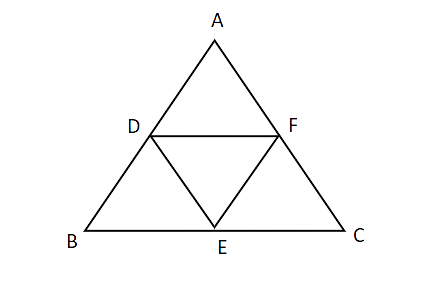
TPT:
Proof: Segment DF joins the midpoints of AB and AC respectively.
By midpoint theorem,
DF || BC
Also, EF || DB
We know that, a diagonal divides a parallelogram in two congruent triangles.
Similarly,
And,
From (i), (ii) and (iii)
Hence proved.
17. Prove that the line joining the mid-points of the diagonals of a trapezium is parallel to the parallel sides of the trapezium.
Ans: Given: ABCD is a trapezium
AB || CD
TPT: AB || CD || EF
Construction: Join DF and produce it at G to meet AB.
Proof: EF is joining the midpoints of unparalleled sides AD and BC respectively.
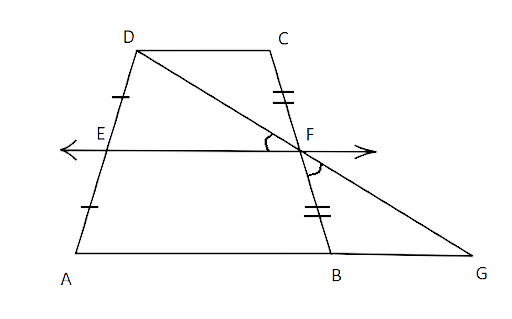
In
(i)
(ii)
(iii) FC = FB (F is the midpoint of BC)
By AAS test of congruence,
Thus, DF = GF and DC = BG (by CPCT)
Now, in
F is the midpoint of BC and E is the midpoint of AD,
So, by midpoint theorem,
EF || AB
But, AB || DC
Hence proved.
18.P is the mid-point of the side CD of a parallelogram ABCD. A line through C parallel to PA intersects AB at Q and DA produced at R. Prove that DA = AR and CQ = QR.
Ans: Given: DP = PC
AP || RC
TPT: DA = AR and CQ = QR

Proof: In
DP = CD (P is the midpoint of CD) and AP || CR
Thus, A is the midpoint of DR
But AD = BC
So, AR = BC..(a)
Now, in
(i)
(ii)
(iii) AR = BC (from a)
By AAS test of congruence,
CQ = QR (by CPCT)
Therefore, AD = AR and CQ = QR
Hence proved.
If any of the Exemplar problems appear to be troublesome then referring to the NCERT Exemplar Solutions Class 9 Math Chapter 8 by Vedantu will be very helpful. Vedantu created the best study material for the Quadrilaterals through NCERT Exemplar Solutions to make your study time simple. These materials will assist you with upgrading your understanding in regards to the Chapter and consequently will help you achieve more marks in your tests.
FAQs on NCERT Exemplar for Class 9 Maths Chapter 8 - Quadrilaterals (Book Solutions)
1. What are the types of Quadrilaterals in NCERT Exemplar Class 9 Math Chapter 8?
Types of Quadrilaterals:
Trapezium: When the 2 inverse sides of a Quadrilateral are equal, then, at that point, the Quadrilateral is referred to as Trapezium.
Parallelogram: When the two sets of the opposite sides of a Quadrilateral are equal, then it is known as Parallelogram.
Rectangle: When the angle is 90 degrees in a Parallelogram then it is known as a Rectangle.
Rhombus: A Parallelogram whose every one of the sides is equivalent is known as Rhombus.
Square: A Parallelogram whose every one of the sides is equivalent long and it comprises one right angle is known as a square.
Kite: When the two sets of adjacent sides are equivalent and the figure isn't a Parallelogram then it is known as a Kite.
2. What are some important theorems in Class 9 Math Chapter 8?
Some important points in Class 9 Math Chapter 8 are:
A Kite cannot be said as a Parallelogram, a Square is a Rhombus and a Rectangle but a Rhombus and a Rectangle is not square.
The sum of all interior angles of a Quadrilateral is 360 degrees.
A Diagonal of the Parallelogram divides it into 2 congruent Triangles.
A Diagonal of the Square shape divides the Square shape into 2 equivalent parts.
The Diagonal of a Rhombus is divided into 2 equivalent parts making a point of 90 degrees.
Diagonals of a square have equivalent length and divide the square into equivalent parts making an angle of 90 degrees at the convergence point.
3. What are the properties of a Parallelogram in Chapter 8 Class 9 Math?
The properties of a Parallelogram in Math Class 9 Chapter 8 are:
In the Parallelogram each pair of opposite points is said to be equivalent.
The Quadrilateral is known as a Parallelogram if the diagonals of a Quadrilateral divide themselves into 2 equivalent parts.
In the Chapter, you will have some familiarity with the different properties of a Parallelogram alongside the midpoint theorem.
4. How many exercises are there at the end of NCERT Math Chapter 8 Class 9?
Chapter 8 contains 4 activities that exclusively cover every one of the subjects of the Chapter.
Practice 8.1 comprises 7 different decision questions where you have to pick the right choice. There are questions dependent on finding the points of Quadrilaterals and the angles between the diagonals of various Quadrilaterals.
Practice 8.2 has 7 questions in which you need to give appropriate thought to the situation mentioned. For example, you have to demonstrate that if a figure contains 4 acute angles or are the diagonals of a figure are equivalent and opposite, and so forth.
Practice 8.3 contains 5 questions in which you have to prove a figure as a parallelogram, rhombus, triangle, and so on.
Practice 8.4 comprises 9 questions in which you have to use the midpoint theorem. Also, you have to show in case the Quadrilateral is a Parallelogram, a Square, and so forth. Further, you will be asked to prove in case the diagonal separates the point of a Quadrilateral, Square, Rhombus, etc.
5. What are the benefits of using Vedantu solutions for NCERT Exemplar Class 9 Math Chapter 8 - Quadrilaterals?
Math is one of the most intense subjects among the students of Class 9. However, the experts at Vedantu aim to make every one of the parts simple for you.
In case you have been revising NCERT Exemplar Class 9 Math Chapter 8 problems, and confronting problems to find the right arrangements, then Vedantu will end up being the best instructive team. The experts give you the customized notes just as the proper answers for each question referenced in NCERT Exemplar.
Every one of the solutions is made according to the most recent CBSE exams design for Class 8 Math and follows the NCERT prospectus as well.



































